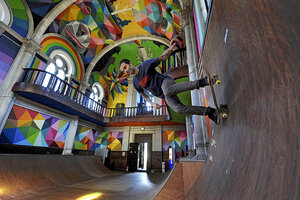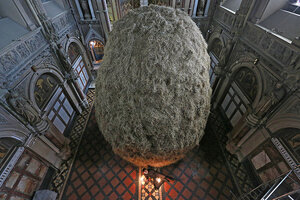How much should a former church’s past affect its future use?

A man practiced skateboarding inside the deconsecrated Santa Barbara church in Llanera, Spain, in January 2016. The church had been abandoned for decades.
Eloy Alonso/Reuters
Toronto; and Rome
Religion plays no role in the professional life of Drew Sinclair, a principal of the contemporary architectural firm SvN in downtown Toronto. But when he sets out to repurpose a church here – a growing architectural niche across the West – he is guided by a teaching found in the Bible.
It is the Parable of the Talents, which was shared with him by an Anglican bishop whose congregation was wrestling with its own redevelopment. In one version of the biblical tale, three slaves are put in charge of goods while their master is away. When the master returns, each servant is assessed according to his stewardship. While two invest wisely, one buries the “talent” in the ground, fearful of losing it. He is punished for the missed opportunity.
For Mr. Sinclair the lesson is clear for churches, as they face dwindling congregants in buildings that are increasingly hard to maintain and often sitting on prime real estate. If they stand unwilling to budge, they may end up “burying” their possibilities; or they can adapt to the needs of their communities today, even beyond the faith mission. “If we keep them as carcasses of themselves, they will fail,” he says. “If we figure out how to make them lively and active and real parts of their communities … then they are doing well by their original purpose.”
Why We Wrote This
As religious buildings hit the real estate market in an era of shrinking congregations, some are weighing how to strike a balance between the buildings’ former purposes and communities’ modern needs.
These are the kinds of considerations that priests and church leaders, not to mention architects, developers, and urban planners, must make as they attempt to halt the abandonment, desecration, and complete sell-off of centuries-old structures amid a wave of secularization. So concerned is the Vatican about the potentially profane uses for Catholic churches that it convened the first ever conference devoted to the issue in November entitled “Doesn’t God Live Here Anymore?”
The losses they face are clear. In the Netherlands, for example, a third of the country’s 1,600 Catholic churches are due to fall out of religious use in the next decade. In Canada, one-fifth of Catholic churches have been deconsecrated since 2000 amid a drop in church-goers. Fifty years ago in Quebec, around 80 percent of people attended mass; that stands at 10 percent today, says Paul-André Durocher, the archbishop of Gatineau. “Many villages are becoming ghost towns and they can’t afford the upkeep of big stone buildings, especially when you consider what our harsh Canadian winters can do to them,” he says. “The reality is that we have too many churches.”
And the Catholic Church is far from alone in grappling with how to respond to market forces today. According to a Ministry of Tourism and Culture guide from Ontario, some 12,000 properties in the Canadian province are now or were historically in religious use. Of these, about half remain religiously active.
Yet as they are sold off, critics say too little long-term thought is being given to what they might become: bars, restaurants, nightclubs, and in some cases even strip joints.
Congregations are particularly vulnerable in hot real estate markets. In Toronto, many churches are now luxury condominiums with units that can fetch a million dollars or more.
David Deane, an associate professor of Catholicism and moral theology at the Atlantic School of Theology in Halifax, Nova Scotia, says sell-offs to the “highest bidder” fail to account for the trends that could reverse over time. For starters, immigration is changing religious make-ups. Whether Poles in Britain or Latin Americans in the United States, newcomers have revitalized older houses of worship. And if traditional faiths are losing members, start-up evangelical churches are booming in places. Plus, he says, customs change. “We in the West, we have very short memories. We assume that the second half of the 20th century, from 1930 on, was a world in which everyone goes to church, and that it was always this way.” That is wrong, he says, and the lesson for him is clear: Even if people aren’t church-going today, they could be in the next century.
That’s what the Church of St. Mary and St. Martha, part of the Anglican diocese of Toronto, is grappling with today. It sits in a neighborhood that once was a Protestant-dominated village in the west end of the city. But the community gave way to high-rise construction that has brought new immigrants and left many old churches like the Church of St. Mary and St. Martha empty. The church rents pews to an evangelical Ghanaian congregation, but they need new partners, faith or community providers, to sustain the property.
On a railway line, developers were eyeing the land for condos, an idea that some congregants entertained. They instead contracted SvN to envision the possibilities for the future: what the religious demographics might look like, in their own community but also among newcomers, thinking in ways “churches usually don’t think,” says Sinclair. These conversations are what Sinclair calls the hardest aspect of redevelopment, well before the technical challenges of converting a church begin.
A year after discussions began, they still don’t have a concrete vision – except they won’t turn into housing. “They realized that was the death knell for them,” says Sinclair. “They are reducing their footprint, taking a large payout or sum, and they are left in the same position, where they are shrinking and they are no longer a highly visible partner within the community.”
That is in line with guidelines in the last six months from the Anglican Church’s Archdiocese of Toronto, which worked with SvN to study 20 churches that have undergone the process of redevelopment. For now the Archdiocese has decided to halt further site sales in acknowledgement of the vulnerability they face, says Sinclair. “We are going to slow down. There is too much interest. It’s too hot right now in this marketplace. We are going to lose all of our inventory and any potential for future growth.”
The Vatican, too, is working on a global standard for how to manage the sale of deconsecrated churches so that they can ideally be put to community, rather than commercial, use. “This is going to be a big issue in the future and that’s why guidance from Rome is so important,” says Sophie Andreae, vice-chair of the patrimony committee of the Catholic Bishops Conference of England and Wales.
In a message sent to the Rome conference, Pope Francis acknowledged a decline in the number of faithful but said that deconsecrated churches could be given “a new life,” preferably in service of the poor.
This is not a desire to hold onto a building for the sake of it, either out of power or nostalgia, says Professor Deane, but to make an intentional choice that does not “surrender to the power of capitalism.”
Churches often play anchoring roles in communities as hubs, beyond the congregations they serve. Churches are often the last community space left, he says. “And to see that hub getting blown up again in favor of the inexorable flow of capitalist power, I think that can also destabilize and hurt the whole community.”

